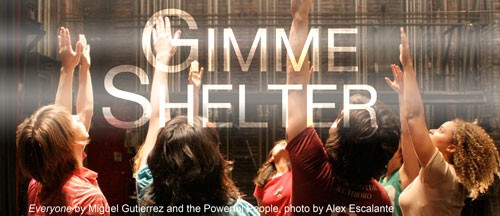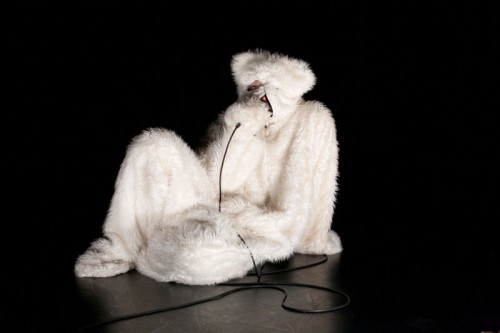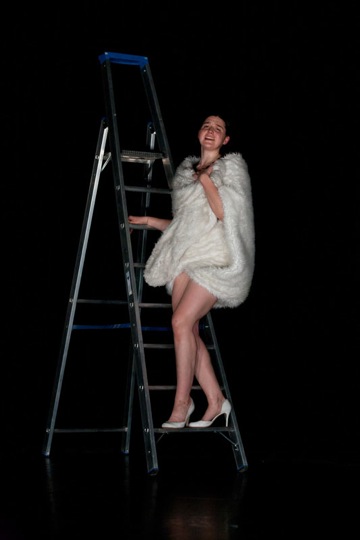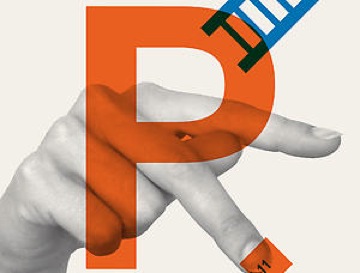
Performa 11 logo.
November brings with it the sweeping Performa 2011 Biennial, filling theaters, galleries, churches and plazas across New York City. This is the fourth Biennial to date, and the most far-reaching, ambitious and populated. Roselee Goldberg, founder of Performa, is the famed art historian who is known for authoring a history of performance art in her books, Performance Art: From Futurism to the Present and Performance: Live Art Since 1960. Goldberg also was curator of The Kitchen in the 1970’s, putting it on the map as a leading venue for experimental forms.
Goldberg’s books, taught widely in universities and art schools, place performance alongside painting and sculpture as part of the art historical canon. They make the case for performance art as a form that can be traced through multiple disciplines and which continues to play a significant part in the art world. Of course, I jumped at the chance to cover Performa and was more than eager to absorb the energy, experimentation, absurdity, profundity and dialogue this Biennial has to offer. On November 1, I jumped into the loosely themed “Constructivism and Fluxus” rabbit-hole and bid my quotidian comforts adieu, to be taken up again after the upcoming three weeks had passed. Oh, promises of exhilaration.
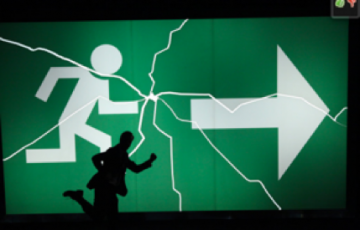
Running nowhere fast, Joseph Feines as Ingar Dragset in "Happy Days in the Art World," 2011. Image from whitewallmag.com.
Am I having an experience yet? Maybe. Nope, not yet. Now? And so the weeks progressed…what was a rabbit-hole became a black hole of amateur theater made by blue chip visual artists. With many tickets at steep rates for commissioned works, the hype outweighed the reality. Paradoxically, giving visual artists time, space and funding to create performance has resulted in an experience that is not even half as good as going to 42nd street. If you’re going to the theater, why not just pay those prices to see a real show?
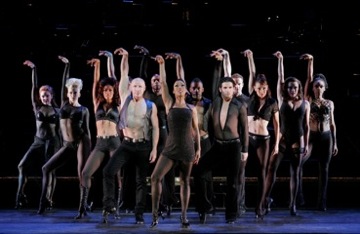
"Chicago," the Broadway musical. Image from broadwayworld.com
Goldberg claims that performance art is stuck in the 1980’s and needs to be brought into the 21st century; however, my experience of much of Performa’s “visionary” performances is that they were actually quite conventional. Were I to see Performa from the standpoint of the average art viewer, I might perceive performance art as plays, or worse yet–as mime. Yes, miming art historical movements through the artifice of spectacle. For all intents and purposes, it might be more accurate to describe it as “Performa: Theater Camp for the 21st Century.” Yet now that I have given voice to my dashed expectations, I am also prepared to say that there have been some redeeming moments to Performa. These moments have mainly occurred because some actual performance artists were invited to participate.
Eleanor Bauer’s solo performance Big Girls Do Big Things at New York Live Arts proved to be an outrageous adventure into the plight and privilege of the statuesque young choreographer. Slipping into a polar bear suit as she took the stage, Bauer attempted to stand up despite the suit’s bulky, misshapen folds and tucks that hindered her. She kicked two small cymbals and then searched for a way to clap them together with her paws. Not merely slapstick, the bear suit performance parodied her appearance as a “big girl” in a world of idealized dancer bodies. The difficulty with which she moved, encumbered by the suit, revealed a sad truth about the projections that audiences themselves put onto stage performers. Like a circus act, the “bear with cymbal” routine symbolizes the performers’ labor for cheap laughs and approval from audiences, but when the cymbals started to become slippery, and the roly-poly behavior of the bear broke down, the dysfunction of the performer’s role is made clear.
Bauer then transformed the suit into a kind of chic coat-dress and, now in high-heeled shoes, began to mount a ladder. As she climbed each rung, she sang Patsy Cline’s “Crazy,” at perilously higher octaves. By the time she reached the top of the ladder, Bauer was practically shrieking. It’s a dangerous moment: teetering in the heels, sweaty, and digging deep into her diaphragm for breath, it seemed like Bauer might not be able to sing a last chorus. But when she did, it provided another one of those slapstick-turned-dark moments, especially as the last echoes of the lines “I’m crazy for trying/ and I’m crazy for crying/ and I’m crazy for loving you” filled the stage with a haunting sense of desperation.
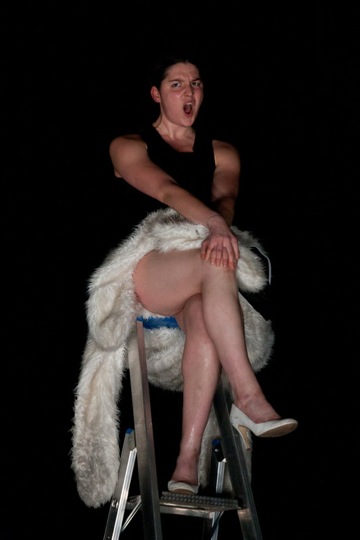
Bauer reciting a monologue based on a performance by Karen Finley. ("Nothing Happened.") Photo by Nada Zgank.
As she sat at the top of the ladder, Bauer recited a monologue based on Karen Finley’s performance Nothing Happened from 1986. Bauer’s version, “so I went on a detox diet and nothing happened/ so I became macrobiotic and nothing happened/ so I ate a protein shake with extra spirulina and wheat grass and noni juice and acai-berry and ginseng and guarana and ginko and echinacea and kumobucha and l-carnitine and chromium, and flax oil, baby, and nothing happened…” points to her body again, and to the cultish, techno-organic vocabulary of over-the-top health consciousness. Statements like, “I spent a half an hour per day signing petitions on the internets, and nothing happened. I joined moveon.org, truemajority.org, unitedforpeaceandjustice.org, I joined avaaz.org, One Million Strong, and nothing happened. I went to the rallies, I protested the war in Iraq seven times, and nothing happened!” point to the effort it takes to try and connect with others and take action within a sea of competing political and social causes and their ongoing exploitation. Big Girls Do Big Things had all the elements that were antithetical to Performa itself–a bear suit, a sentimental song, a monologue from the 1980’s–but in its fierce simplicity, Bauer’s piece managed to rank among the most contemporary and confrontational of the Biennial’s works.
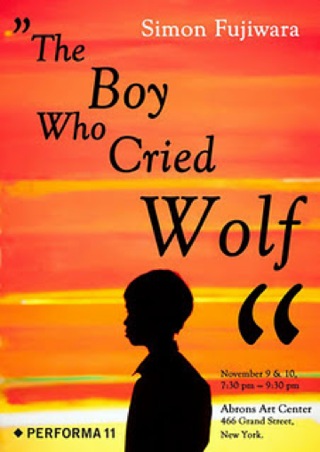
Simon Fujiwara likewise employed personal material and monologue in his performance The Boy Who Cried Wolf at Abron’s Art Center. With a rotating set and scenes consisting of a mirrored museum/bedroom, a Spanish bar, and a wedding reception, Fujiwara spun tales of his boyhood growing up Japanese in homogenous St. Ives, England, of his parents’ Catalan-inspired “Hotel Munber,” run under Franco’s dictatorship, and of the mockery of marriage and the spectacle of the wedding ceremony. In some ways, his performance felt like a glamorized artist talk, in that it was all about Fujiwara’s identity as an artist and as a homosexual in relationship to societal prejudice and familial silence.
Keeping his back to us, Fujiwara spoke to a boy who was facing the audience, and instructed him on how to play himself. Fujiwara then relayed the story of how, at age eleven, he saw a Patrick Heron painting that made him realize that he “wanted to be an artist and was gay.”
Fujiwara then projected an image of an Ikea catalogue showing all the merchandise that contained the same pattern as the painting, and pointed out the bedspread, pillow and ironing board on the set with it. The boy must “act out” the revelations in a silent scene, where he goes up to a print of the painting, is overcome and then folds himself into the Ikea sheets. Fujiwara is a master at taking powerful and sensitive moments in his personal life and weaving them into visual art that is both evocative and humorous. Each time a new story emerged, the artist kept the dynamics shifting and never rested on one tone or emotion. As a result, moments that seemed dark were hilarious, and moments that were matter-of-fact had an unexpectedly weighty quality.
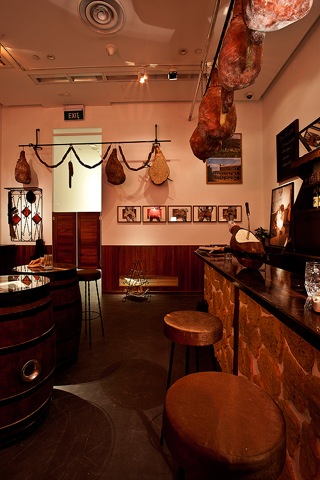
Simon Fujiwara's "Welcome to the Hotel Munber" installation at the Singapore Biennale, which was adapted and presented onstage for Performa. Image from www.singaporebiennale.org/.
This subtlety beneath the on-point delivery of say, a Flamenco guitar-accompanied, homo-erotic soldier story, or a slide-show of ornamental doorknobs with farcical masochistic tales of arousal from interior design, had to them an air of glamorous melancholia. It read more as Fujiwara’s personal oppression (internalized or public) about his homosexual identity than, “Isn’t it so Dada to think of a Japanese family running a Catalonian bar with a queer child writing about its lascivious patrons?”

Simon Fujiwara digging for Franco. Image from www.veralistcenter.org.
In much the same way that Felix Gonzalez-Torres evokes the longing for intimacy in the face of loss, Fujiwara’s monologues seem to address a silent other who has forgotten him, but for whom he continuously calls out. This is apparent in the faux wedding reception where Fujiwara described finding a camera in a taxi to see that it is full of photographs from multiple weddings. He tracked down the owner through Facebook and attempted to friend the other people, whose images he recognizes in the photograph. This absurd moment of extreme stalkerish behavior shows our image-obsessed culture of making, procuring and cultivating a sense of connection with others, as if to ward off the void of isolation. But it’s not just that, it’s Fujiwara in his internal exile looking at a white, hetero-normative world and wondering where the real intimacy is found within all of the political and cultural bargaining for the institution of marriage.
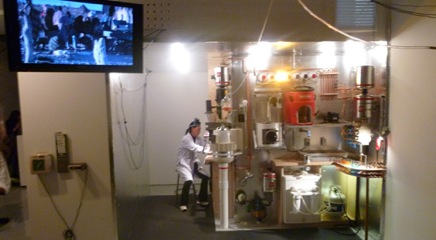
The laboratory of "Seven." Performa commission by Mika Rottenberg and John Kessler. Image from www.thelmagazine.com.
At Nicole Klagsbrun in Chelsea, visitors rotated in and out at half hour intervals to see Seven, the performance-installation by video artist Mika Rottenberg and sculptor/machine-maker John Kessler. Occupying an entirely different performance world than the above-mentioned solo performances, this piece was run by many performers who played lab technicians, bicyclists and sauna-sitters activating a “chakra-juicer” that in turn fueled a surreal color explosion in Botswana.
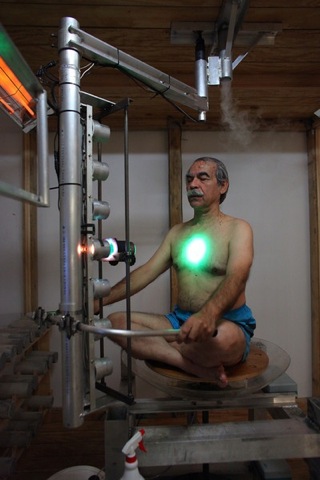
Sweating in the "chakra juicer" sauna. Image from www.artinamericamagazine.com.
Viewers watched as a performer would go into the small, transparent sauna, choose a color from the ROYGBIV chakra lantern, and begin to sweat while another performer rode a stationary bicycle attached to the sauna. Sweat drops were collected through a tube and emptied into a glass vessel by a “technician” who converted it into a dye-colored “juice.” In one half-hour period, this cyclical routine occurred about four times, while simultaneously a video of Africans digging samples from the earth and bringing them to a machine that conveyed the samples to the gallery was played. What ensued was a fantastical activation of a brief-case sized chakra-light machine that electrified the juice. It was then spilled back into the earth, culminating in an animated eruption of streaming colors and birds.
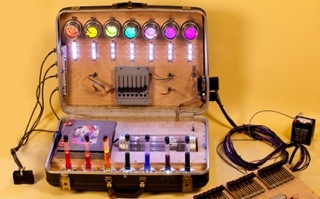
The alchemical chakra machine. Image from Performa 11's website, https://11.performa-arts.org.
So many parts of Seven were complete anomalies: a sauna in the middle of a gallery, scantily-clad performers who appeared pedestrian in nature, a virtual laboratory with intricate lighting and sound that gave the effect of something real happening, and the shared dream that we were experiencing the performance alongside those in a village in Botswana. The success of the piece lies in how it references the fitness-productivity and mechanized culture of Russian Constructivism, and Fluxus-inspired absurdity, within a contemporary context of relational art and global exchange.
As part of the 52 hour -long Fluxus Weekend, Bibbe Hansen, daughter of the late Al Hansen, gave a performance-lecture at Golden Gallery and participated in the Fluxus concert. Her lecture on “growing up Fluxus,” and the ways her father raised her as an artist and thinker, culminated in a reenactment of Al Hansen’s Elegy for the Fluxus Dead. Bibbe performed in front of a projection of Al’s performance, bringing the historical significance of her father’s legacy up to the present through the experience of her voice. At the end of the performance, Bibbe wrapped her entire head in masking tape to reflect Al’s action on the video. This disturbing, hilarious moment is quintessentially Fluxus, but there was also a deeper experience that came from witnessing a daughter trying to do justice to her father’s legacy.
[youtube:https://www.youtube.com/watch?&v=3aocehZhv1M]
My brief descriptions of these performances are by no means meant to be exhaustive, nor do they convey the full breadth of events that have taken place during the Performa Biennial thus far. On Monday, November 21, Performa will come to an end. In Part 2 of this two-part blog post, I’ll report on Performa’s last week while touching on some of the performances I’ve seen that fall outside the scope of this Biennial. In the meantime, I’ll be drinking the Kool Aid in hopes of spontaneous revelation.

